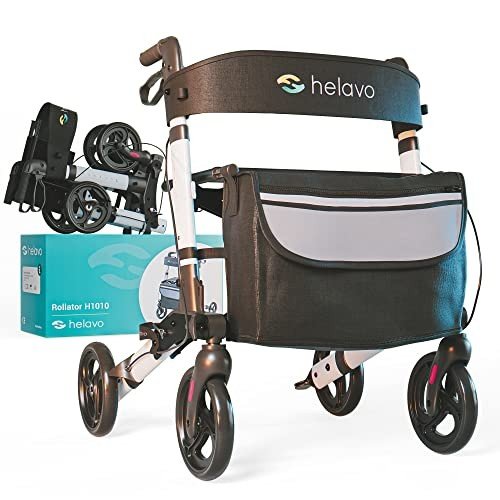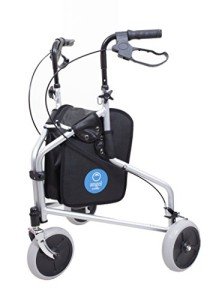Wpis na blogu utworzony przez Jessie Kincaid
Understanding Rollators with Wheels: A Comprehensive Guide
Rollators, likewise referred to as wheeled walkers, have actually ended up being increasingly popular amongst individuals seeking mobility support. These innovative gadgets offer a mix of assistance, stability, and benefit, making them perfect for seniors and people with specials needs. This article checks out the features, benefits, types, and factors to consider of rollators with wheels, together with frequently asked questions to assist you make an informed choice.
What is a Rollator?
A rollator is a mobility gadget geared up with 3 or four wheels, hand brakes, and a frame created for stability. Unlike traditional walkers, which need users to raise the gadget to move, rollators glide efficiently, allowing users to walk naturally while receiving assistance. The majority of rollators likewise consist of a seat for resting, making them particularly advantageous for those who might tire easily.
Key Features of Rollators
- Wheels: Generally created with either 3 or four wheels, providing balance and stability while walking.
- Hand Brakes: These brakes enable users to stop the rollator securely while promoting confidence during use.
- Seat: Many rollators come geared up with a seat for resting, ideal for users who might require to take breaks during strolls.
- Basket or Storage Bag: Convenient Mobiclinic® Foldable Shopping Trolley with Seat for bring individual items, shopping, or essentials during outings.
- Adjustable Height: Frames are frequently adjustable for a customized fit, accommodating users of various heights.
Benefits of Using a Rollator with Wheels
Rollators provide many advantages for individuals with minimal mobility. Some of the key benefits include:
- Enhanced Mobility: Rollators enable users to maintain independence and mobility, making it much easier to browse inside your home and outdoors.
- Improved Stability: The presence of wheels and brakes supplies additional support, lowering the risk of falls.
- Convenience of Use: Users can walk naturally without requiring to lift the device, which can ease strain on the arms and back.
- Comfy Seating: Users can take breaks whenever needed, reducing fatigue and enabling longer outings.
- Increased Confidence: With better support and stability, users may feel more protected in their movements, resulting in higher mobility.
Types of Rollators
When considering a rollator, a variety of choices are available to deal with diverse needs:

Standard Rollators: Typically featured four wheels, larger frames, and a comfortable seat, making them appropriate for many users.
Compact Rollators: Designed for indoor use or travel, these rollators are GYMAX Lightweight 3-Wheel Rollator with Shopping Bag, foldable, and frequently feature smaller sized frames.
Heavy-Duty Rollators: Engineered for users who might require extra support, these rollators generally have a greater weight capacity and a larger frame.

Three-Wheeled Rollators: More maneuverable than their four-wheeled counterparts, these rollators are ideal for navigating tighter spaces.
Factors to consider Before Purchasing a Rollator
Before buying a Bariatric Rollator, there are a number of elements that need to be thought about to guarantee the very best fit for individual needs:
- Weight Capacity: Check the weight limit to guarantee it supports the user's weight adequately.
- Frame Size: Ensure that the frame fits the user's height for optimal comfort and support.
- Wheel Size: Larger wheels are usually better for outdoor use and rough surface, while smaller sized wheels are more fit for indoor use.
- Storage Options: Consider how much storage is required for mobility aids, shopping, or individual products.
- Portability: If travel is a priority, Rollator For Tall People select a foldable and lightweight model for ease of transport.
Upkeep of Rollators
Appropriate upkeep can extend the life of a rollator and make sure safety throughout use. Here are some ideas:
- Regularly Check Brakes: Ensure that hand brakes function correctly and adjust them as required.
- Inspect Wheels: Look for wear and tear; replace wheels if they reveal signs of damage.
- Tighten Loose Parts: Regularly examine for any loose screws or bolts and tighten them to maintain stability.
- Tidy the Frame: Wipe down the frame regularly to keep it complimentary from dirt and debris.
Table: Comparison of Rollator Types
| Type of Rollator | Wheel Count | Ideal Use | Weight Capacity | Mobility |
|---|---|---|---|---|
| Requirement Rollator | 4 | General mobility | 300 lbs | Moderate |
| Compact Rollator | 4 | Indoor/Travel | 250 lbs | High |
| Sturdy Rollator | 4 | Strenuous use | 400 lbs | Low |
| Three-Wheeled Rollator | 3 | Tight areas | 300 lbs | Moderate |
Frequently asked questions About Rollators with Wheels
Q1: How do I pick the ideal rollator for my needs?
A1: Consider factors such as your height, weight, and where you'll primarily use the rollator (indoor vs. outdoor). A trial at a mobility shop might also assist you find a comfy fit.
Q2: Are rollators hard to maneuver?
A2: Most rollators are developed for ease of use, and with practice, users typically find them easy to steer, especially those with rotating wheels.
Q3: What is the average cost of a rollator?
A3: Prices can vary considerably, from roughly ₤ 70 for basic models to over ₤ 300 for high-end or customized models.
Q4: Can rollators be used outdoors?
A4: Yes, numerous rollators are created for both indoor and outdoor use. Nevertheless, choosing one with bigger wheels can improve stability on unequal terrain.
Q5: How do I preserve my Rollator With Wheels?
A5: Regularly examine the brakes and wheels for wear, tighten any loose parts, and clean the frame regularly to ensure safety and durability.
Rollators with wheels are essential mobility aids that promote independence and security for users. By understanding the features, benefits, and maintenance of rollators, individuals can make informed choices about their mobility needs. With the right rollator, users can delight in better mobility, self-confidence, and quality of life.
